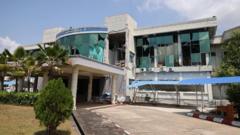Myanmar's military leader, Senior General Min Aung Hlaing, announced during a recent government meeting that the city’s layout will undergo substantial changes in the wake of the catastrophic earthquake that struck on March 28th. This natural disaster, registering a magnitude of 7.7, caused widespread ruin throughout the city, and was felt as far away as Thailand and China. Approximately 70% of government infrastructures faced damage, prompting the relocation of several offices to Yangon.
According to the military's assessments, collapses were aggravated by construction on unstable soil, leading to new mandates requiring future office buildings to withstand seismic activity. Prior to any reconstruction efforts, tests will be conducted to evaluate the soil conditions.
The past two years have been turbulent for Myanmar since a military coup unleashed violence and civil unrest, with resistance forces continuing to clash with the military council, despite a temporary ceasefire declared recently to facilitate aid efforts. The historical context of Nay Pyi Taw remains noteworthy; this planned city has existed only since 2005 and holds vast open spaces with minimal population density.
Among the severely impacted structures were key entities like the Ministry of Labour and the Ministry of Planning, many of which still lie in disrepair. In a scramble to safeguard valuable possessions, staff from various ministries are conducting the relocation of crucial documents and equipment away from damaged sites, while temporary structures are being utilized for some departmental functions.
In summary, the reconstruction of Nay Pyi Taw may take years, persisting amid the ongoing challenges presented by the civil conflict, raising questions about the dual role of aid amid turmoil. As Myanmar navigates this critical juncture, the military government’s efforts will need to adapt to both humanitarian needs and infrastructural resilience to ensure the future stability of its capital city.
According to the military's assessments, collapses were aggravated by construction on unstable soil, leading to new mandates requiring future office buildings to withstand seismic activity. Prior to any reconstruction efforts, tests will be conducted to evaluate the soil conditions.
The past two years have been turbulent for Myanmar since a military coup unleashed violence and civil unrest, with resistance forces continuing to clash with the military council, despite a temporary ceasefire declared recently to facilitate aid efforts. The historical context of Nay Pyi Taw remains noteworthy; this planned city has existed only since 2005 and holds vast open spaces with minimal population density.
Among the severely impacted structures were key entities like the Ministry of Labour and the Ministry of Planning, many of which still lie in disrepair. In a scramble to safeguard valuable possessions, staff from various ministries are conducting the relocation of crucial documents and equipment away from damaged sites, while temporary structures are being utilized for some departmental functions.
In summary, the reconstruction of Nay Pyi Taw may take years, persisting amid the ongoing challenges presented by the civil conflict, raising questions about the dual role of aid amid turmoil. As Myanmar navigates this critical juncture, the military government’s efforts will need to adapt to both humanitarian needs and infrastructural resilience to ensure the future stability of its capital city.

















